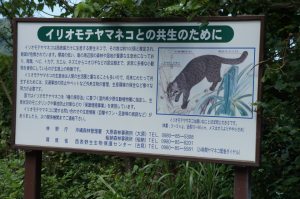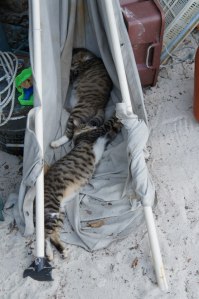For Golden Week this year Lily and I decided to go to Okinawa. Golden Week is three consecutive national holidays on the 3rd, 4th and 5th of May: Constitution Memorial Day, Greenery Day and Children’s Day. On top of that, my birthday is also a Japanese national holiday (you’re welcome) on the 29th April which means if you take the three days in between as 年休 (paid leave) or if they fall on a weekend, you get a nice little holiday in the middle of term before the last leg to summer.
This year, my birthday was on a Monday so I took Tuesday, Wednesday and Thursday as 年休 and as the 5th was a Sunday, they did a Happy Monday thing and moved the national holiday to Monday 6th. Which meant we had nine days off for three days 年休!
Although it is a nice time to travel for JETs, it is also a nice time to travel for everyone else in Japan! Those hard workers who never ever ever use their 年休 suddenly find themselves three days of holiday they have no choice but to relax in (actually, I say that, but chatting with my JTEs this week revealed that they often schedule school sports games over those three days so they usually go with the students somewhere to watch them play). So places like Kyoto and Osaka are suddenly bursting with people.
That’s what Lily and I expected when we booked a four day trip to Ishigaki Island, a tropical and well-known island south of Okinawa. We also had waning hopes for the weather as my iPhone promised heavy rain and storms. Just like last year, our schedule of beaches beaches and beaches would probably need a rethink.
Ishigaki is about three hours south by plane from Fukuoka with a transfer in Naha City. It is, like most places in Japan, famous for its beef and very certain that its beef is in fact the very best of all and it is not to be argued with regarding this.
When we arrived, we were picked up by the car rental company (Jネットレンタル) we had booked through a travel agency and they gave us a dinky silver Nissan March for our trip.
Our hotel was by the ferry terminal that was the only method of transport we could use to get to the smaller islands surrounding Ishigaki. It was early afternoon by the time we checked in at the グランティア Hotel so we began our search for an avocado burger…
 Okinawa is actually famous for its pork and soba noodles, taco rice and this vegetable called goya that they put in everything and I don’tknowwhyittastessoweird. But Lily had been fancying a burger since before we left Karatsu and when we saw an Ishigaki beef burger topped with avocado, we knew that was the lunch for us.
Okinawa is actually famous for its pork and soba noodles, taco rice and this vegetable called goya that they put in everything and I don’tknowwhyittastessoweird. But Lily had been fancying a burger since before we left Karatsu and when we saw an Ishigaki beef burger topped with avocado, we knew that was the lunch for us.
Except it wasn’t because the restaurant was closed. T_T
So we had the pork soba thing that was very tasty. They had an original kind of vinegar they wanted us to try that was dericious and the salt and pepper gave the slightly-too-fatty pork a nice flavour.
By then the sky had cleared so we rushed off to a nearby beach to enjoy potentially the only sun we would get for the duration of the trip. Fusaki Beach is apparently known as a good spot to view sunsets and we certainly weren’t disappointed. Watching the sun set and listening to a shamisen band perform for an outdoor BBQ place next to us really made us excited to be on holiday. The first few weeks since starting back at work in April are always a little strange in Japan due to all the staff and teacher changes so it was nice to get away and forget about our responsibilities as cultural representatives and looking busy in the teachers’ room while everyone rushes around us trying to do their jobs… Ahem.
we would get for the duration of the trip. Fusaki Beach is apparently known as a good spot to view sunsets and we certainly weren’t disappointed. Watching the sun set and listening to a shamisen band perform for an outdoor BBQ place next to us really made us excited to be on holiday. The first few weeks since starting back at work in April are always a little strange in Japan due to all the staff and teacher changes so it was nice to get away and forget about our responsibilities as cultural representatives and looking busy in the teachers’ room while everyone rushes around us trying to do their jobs… Ahem.
After a tower of sashimi for dinner at an izakaya in town, we went back to the hotel wishing for the weather to be beaming sunshine the next day and when we woke up to my horrid alarm, we were in luck! It was beautiful sunshine outside and it was my birthday and we were going to an island and enjoying nature, dammit!
The ferry port is a five~ten minute walk from our hotel and we made it just in time for the ferry we wanted to take to Iriomote Island, about forty minutes away.
Here are some Wiki facts about Iriomote before you read and trust everything I’m about to write!
Our plan was to spend the morning there on a river cruise then an hour hike through the jungle to look at a pretty waterfall then spend the rest of the day on a beach. But ferry times and bus times and cruise times made us realise that wasn’t going to happen.

When we arrived at Iriomote there was a big sign showing off the islands special wild cat that hides in the jungle and comes out at night. There are only about 100 of them, even the islanders rarely see them and they were all I could think about. Their rounded ears, their “stop taking pictures of me or I’ll bite your face off” faces, their stubby tails- arrrrgggghhhh, adorable!!!
We took a bus out to the river cruise place, realised we were stuck on the island for the day, realised we weren’t really prepared to be stuck there for a day and asked one of the boat drivers whether there was a corner shop or restaurant nearby.
He said, “Do you have a car?”
We said, “Er… no.”
He said, “Alright, I’ll take you somewhere.”
Driven by hunger (it was 10am after all) and all caution cast aside because we were desperate and on holiday in Japan, we followed him to his car.
“As it’s early,” he said, “Let’s check out some of the beaches,” and proceeded to give us our own personal tour of the island! He pointed out a small bird called shiroharakiuna in Japanese that is the Iriomote cat’s favourite prey and proudly told us that Ishigaki beef is the best beef in all of Japan. He plays the shamisen and has travelled around Europe playing with his band but is especially fond of Indonesia where he goes on holiday every year.
 The first beach we went to was Hoshizuna Beach. He walked up to the shoreline and told us to press our hands into the sand. We did so and looked at the sand on our palms and the grains were shapes of tiny stars! This is like one of two beaches or something where you can find that kind of sand. Lily bought me a small bottle of it and we went to the next beach to look at the lilies growing on the cliff face before driving off to the restaurant he owns! And while we ate lunch he played his shamisen and gave us free pineapple as a birthday present.
The first beach we went to was Hoshizuna Beach. He walked up to the shoreline and told us to press our hands into the sand. We did so and looked at the sand on our palms and the grains were shapes of tiny stars! This is like one of two beaches or something where you can find that kind of sand. Lily bought me a small bottle of it and we went to the next beach to look at the lilies growing on the cliff face before driving off to the restaurant he owns! And while we ate lunch he played his shamisen and gave us free pineapple as a birthday present.
I mean, ignoring the news, riots and violent crime for a second, Britain has a lot of kind, gentlemanly people. We help each other out, get prams onto trains etc. When I went to Texas in March, I was blown away by the genuine friendliness of everyone towards each other, hugging each other, saying “Good morning” like they actually really wanted you to have a good morning. But in Japan, it’s like they don’t realise there can be a limit to how much you help people out. I mean, he was at work and he just left to entertain a pair of helpless looking tourists. I mean OK, he got some business out of it when we went to his restaurant but the entire time we were with him, I could see him wracking his brain for more information to tell us about Iriomote and more stories about his Europe tours. I really haven’t experienced this kind of effort anywhere else.
He dropped us back to the river cruise place and we jumped onto the boat that we had entirely to ourselves! This meant we got some great views of the mangrove around us and I could sing Just around the River Bend as loudly as I wanted. I might have seen a spear-crested eagle but it was too far away to tell but we certainly got our fill of the beautiful mangrove trees with their limb-like roots and leaves brushing the surface of the water.
It was now midday and we had a two hour hike there and back before getting the boat back in time for the bus in time for the afternoon ferry. The aim was to see two big waterfalls somewhere in the jungle but I think we managed to miss the first one somehow and by the time we reached the second waterfall we were worried about the time so we took a quick photo of it and dove back into the undergrowth again.

The path was very clear but quite wild and hazardous by Japanese standards. Little lizards with bright blue tails kept dashing out  in front of us and the roots of trees had been left to grow over the path and sometimes it was even muddy! Reminded me of home- except the lizards. We were walking with a steep slope to our right side when we noticed a scatter of leaves and mud. We both glanced down and there was an Iriomote cat outlined against a tree! It was only there for a few seconds then dashed off again but yayyyyy! We saw one! In the middle of the day! Exciting!
in front of us and the roots of trees had been left to grow over the path and sometimes it was even muddy! Reminded me of home- except the lizards. We were walking with a steep slope to our right side when we noticed a scatter of leaves and mud. We both glanced down and there was an Iriomote cat outlined against a tree! It was only there for a few seconds then dashed off again but yayyyyy! We saw one! In the middle of the day! Exciting!

OK, obviously not the wild cat…
Once we made it back to our hotel, we changed and found an American style Deli and Lily finally got her chance to have a burger. With avocado. And it was really good; we decided to go there for lunch the next day.

We got up a little earlier the next day and checked the times for the ferries and set off to Takitome Island, about ten minutes away from Ishigaki. This was clearly a tourist hotspot, probably because it is much closer to Ishigaki and a little easier to get around on as it is only nine miles wide.
Takitome is home to mostly families and the elderly. They have an Elementary and a Junior High School but the High School students have to take the ferry every day to go to school on Ishigaki. Takitome is actually a huge chunk of coral, there are no businesses there (except the tourist businesses like offering water buffalo cart rides and renting flippers and head gear for snorkeling), no police, and they have to get the fresh water pumped over from Ishigaki. It is flat with a few rises but no hills or mountains, no rivers but absolutely stunning beaches and a godswood that no one is allowed to enter. They have a festival for the god that lives there twice a year to offer thanks for looking after them.
 We of course went on a water buffalo cart tour of the village and I learnt most of this from the driver and the family who rode with us as the husband could speak pretty much perfect English (also, they were incidentally from Fukuoka). Our water buffalo was a six year from Hokkaido called Akahachi. As he carted us lazily down the perfect white-sanded streets, the driver picked up his shamisen and played a song for us, stopping every now and then to bellow, “Akahachiiii!” to stop the buffalo from eating grass off the hedgerow or to make him walk again. The white-sanded streets of Takitome are famous in Okinawa and each household is responsible for keeping their own strip of the road clean and neat.
We of course went on a water buffalo cart tour of the village and I learnt most of this from the driver and the family who rode with us as the husband could speak pretty much perfect English (also, they were incidentally from Fukuoka). Our water buffalo was a six year from Hokkaido called Akahachi. As he carted us lazily down the perfect white-sanded streets, the driver picked up his shamisen and played a song for us, stopping every now and then to bellow, “Akahachiiii!” to stop the buffalo from eating grass off the hedgerow or to make him walk again. The white-sanded streets of Takitome are famous in Okinawa and each household is responsible for keeping their own strip of the road clean and neat.
When the tour was finished, the family from Fukuoka recommended that we rent bikes and cycle to one of the nearby beaches. We went to Kondai Beach and it was beautiful! So blue!

We attempted to swim but although it was nice and warm, there was a strong current that wouldn’t let us swim out but rather sideways and then to the shore several yards away from our belongings. So we lay down and got ourselves sunbu— tanned instead.
After stopping at our favourite Deli for lunch, we drove forty minutes northwest over Ishigaki to track down the glass boat company that we had free tickets for.
It was pretty neat seeing the fish so clearly the chasms between the coral fade into a murky blue darkness. And the glass boat captains were very friendly, too. But I don’t think it would have been worth it if we had to pay. I dunno, just go snorkeling. The guy for all his friendliness also just seemed to be rushing it and kept zooming over everything like he wanted us to get back to shore as soon as possible.
It was a very pretty bay though and we bought drinks before setting off to find another beach.

A Shisa shop we found near the beach- I don’t really talk about Shisa in this post but they are awesome
I’ve completely forgotten the name of it but apparently it’s considered the most beautiful beach on Ishigaki but it was very pebbly  and maybe it was because the tide was out but there was nowhere to swim as the shallows were full of corals. I guess it was beautiful though. Surrounded by ragged mountains, pretty light from the sunset, a nice wide kind of bay area.
and maybe it was because the tide was out but there was nowhere to swim as the shallows were full of corals. I guess it was beautiful though. Surrounded by ragged mountains, pretty light from the sunset, a nice wide kind of bay area.
We decided to see whether we could eat at the BBQ place we had seen the first evening we arrived on Ishigaki, with the sunset and the band playing.
 Our whole trip was just one good fortune after another. When we arrived we watched yet another beautiful sunset and then were seated with a good view of the beach and grilled up a feast of pork and beef as the band played into the evening. Such a perfect way to end the trip. We were really quite miserable the next day and the weather was miserable, too; horrid cold rain sluicing down on us as well as a sharp wind.
Our whole trip was just one good fortune after another. When we arrived we watched yet another beautiful sunset and then were seated with a good view of the beach and grilled up a feast of pork and beef as the band played into the evening. Such a perfect way to end the trip. We were really quite miserable the next day and the weather was miserable, too; horrid cold rain sluicing down on us as well as a sharp wind.
This is quite a long post even by my standards and I definitely haven’t written about everything there was to write about (you might be quite relieved about that!) but it was a well-needed and very fun break away from work and I have definitely been feeling the benefits of it since coming back to work this week. So even if your coworkers don’t use their 年休, don’t feel pressured into not using yours; even if our job isn’t exactly nonstop, living in a foreign country can sometimes be tiring so allow yourself to take a break every now and again.
Anyway, big thanks to Lily for organising pretty much everything we did in Okinawa and for being a great, patient, travel companion. 😀

Lily blogged about our trip, too!
Emily x






















